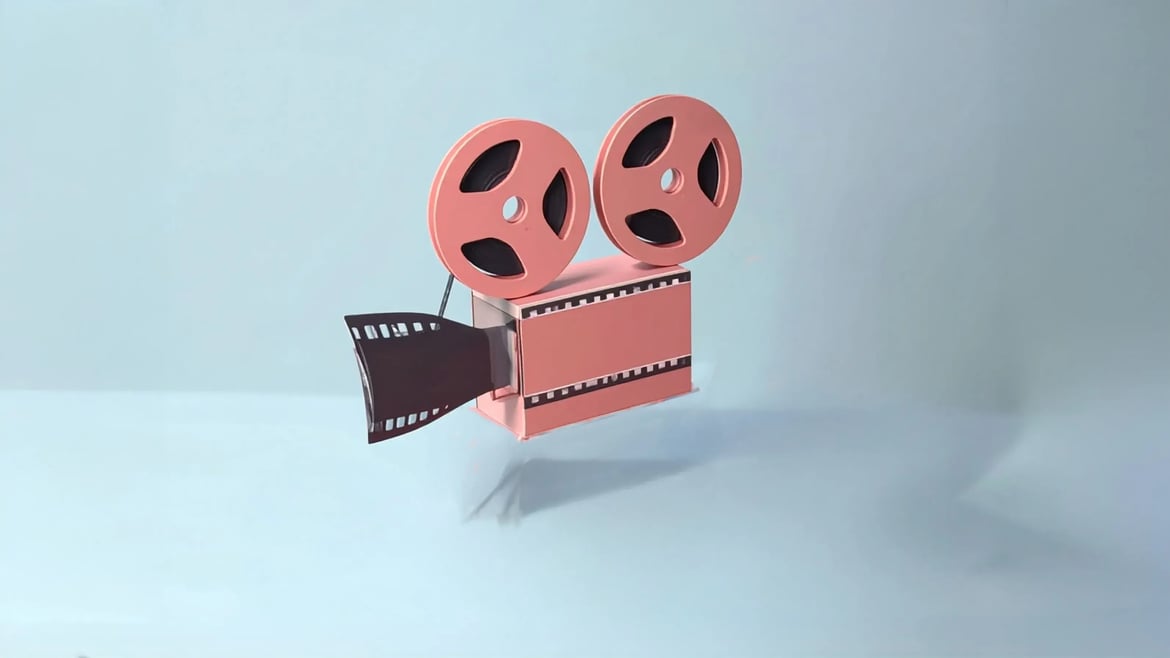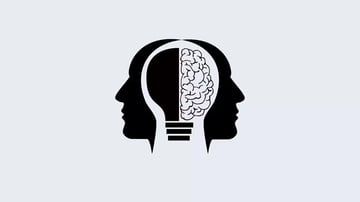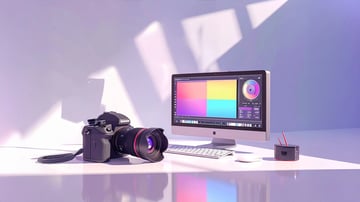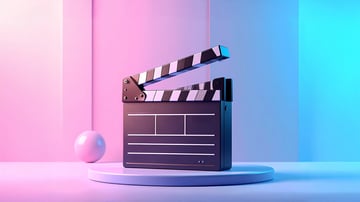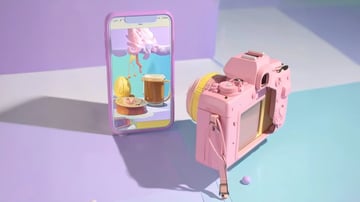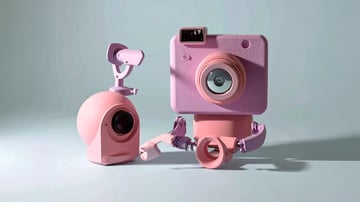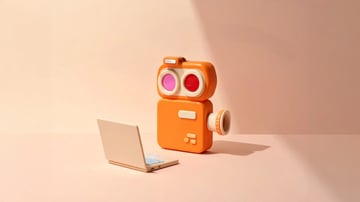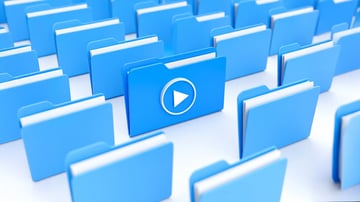Remember those moments in documentaries when the narrator speaks about resilience, and suddenly, the camera drifts to an old factory worker's weathered hands? Or when a travel video talks about a city's spirit, and instead of just hearing about it, you see a bustling street corner at dawn?
Those are the moments of B-roll— the visual poetry that transforms ordinary footage into extraordinary storytelling. While your primary footage tells you what happened, B-roll tells you what it felt like.
B-roll serves as the visual subtext of your story. While your primary footage—what we call A-roll carries the literal narrative, B-roll whispers the emotional truth. It's the difference between being told about a place and actually feeling like you're there.
In this guide, we're going to dive deep into the art of B-roll. We'll explore how B-roll transforms ordinary footage into compelling stories and ways to use B-roll across different genres and styles of video production.
If you want to learn about important shooting techniques for the B-roll, you can check out our blog, “B-Roll Playbook: A Complete Shooting Guide”. Here, we teach you the techniques to shoot the perfect B-roll for compelling storytelling.
Understanding the B-roll
In technical terms, B-roll is supplementary or secondary footage that is intercut with the main footage (A-roll) to enrich the story's visual narrative and provide additional context.
It typically includes establishing shots, cutaway footage, and alternative angles that complement the primary content while maintaining visual continuity and pacing.
You can relate it to news broadcasts when a reporter covers a story about local business growth; you will notice shots of storefronts, people shopping, or workers in action interspersed throughout the main narrative.
This B-roll footage provides visual evidence that supports the story while keeping viewers visually engaged with changing scenes and perspectives.
A-roll vs. B-roll
Now, when you have a basic understanding of what B-roll is, the next question might be how A-roll is different from a B-roll.
While both elements are crucial for storytelling, they serve different purposes. A-roll forms the foundation of your content, carrying the primary narrative and essential information that drives your story forward. It typically features a direct address to the camera, main interviews, or primary action sequences that convey your core message.
While B-roll functions as the visual enrichment layer. It provides supplementary footage that adds more depth, context, and visual interest to your main content. In this way, it helps break up the monotony of a continuous A-roll while illustrating and supporting the primary narrative.
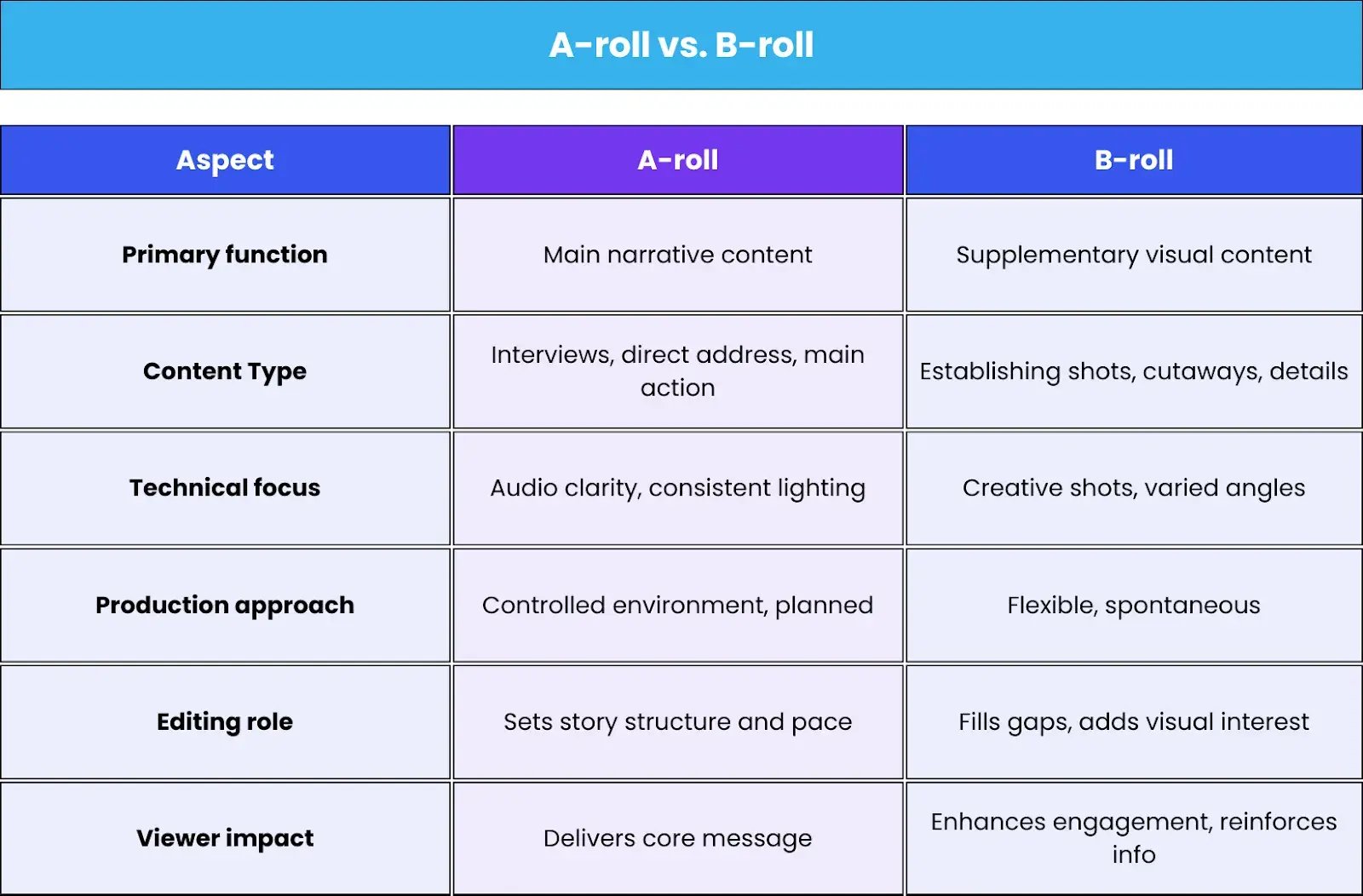
Strategic Uses of B-roll
1. Setting the scene and establishing context
In video production, establishing shots serves as your audience's first introduction to a new location or scene.
B-roll excels in this role by providing vital context before diving into the main content. For instance, in "Chef's Table" (Netflix documentary series), each episode opens with an extensive B-roll of the restaurant's kitchen atmosphere before introducing the featured chef. The B-roll masterfully establishes both the physical and cultural context.
This contextual foundation proves especially valuable in documentaries and news segments where location and environment play crucial roles in storytelling.
2. Demonstrating processes and techniques
B-roll is very useful when it comes to explaining difficult processes in depth or detailing the technical steps of a certain application.
Instead of just talking about a process, the use of B-roll footage allows a person to remember the steps involved more easily as they have actually seen it unfold on screen.
This was particularly useful in instructional materials or for cooking programs and DIY contents sealed with the instructions, given that visual representations are very important to the audience.
3. Creating emotional resonance
B-roll has the unique ability to evoke emotional responses through visual storytelling. When a documentary subject recalls a meaningful memory, a complementary B-roll can transport viewers into that moment.
For example, VICE Documentaries often include powerful B-roll of conflict zones, communities in crisis, and location footage, creating emotional impact alongside interviews. This emotional layer adds depth to your storytelling and helps forge stronger connections with your audience.
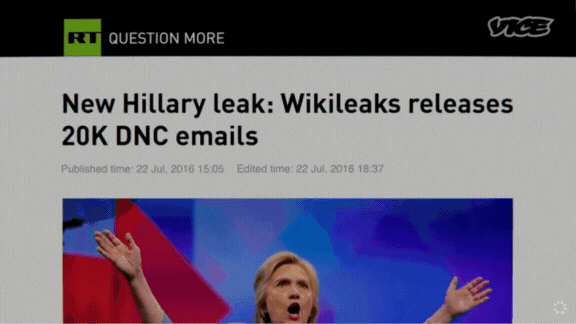
4. Enhancing production value
Even simple productions can achieve a more professional, polished feel through the strategic use of B-roll.
You can create visual depth that elevates your content by providing detailed footage.
This is particularly important for online content creators competing in an increasingly sophisticated media landscape.
A product review, for instance, becomes more engaging and credible when supplemented with a high-quality B-roll showing the item from multiple angles and in various use scenarios.
5. Supporting data and statistics
When presenting numerical data or statistics, B-roll helps transform abstract numbers into tangible reality.
Rather than relying on graphics alone, showing relevant footage that illustrates statistical points helps viewers connect with and remember the information.
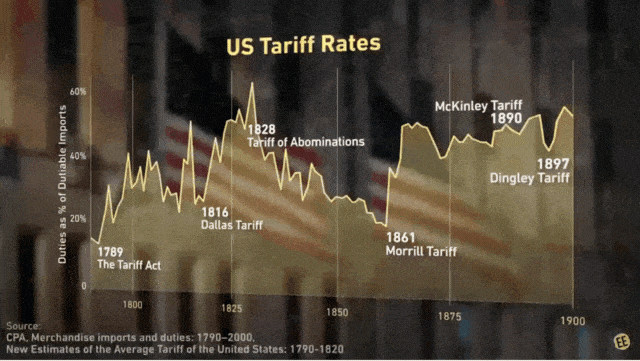
For a news story about urban development, statistics about construction growth become more meaningful when paired with a B-roll of active construction sites, new buildings, and community impact.
6. Adding visual interest to voice-overs
Voice-over segments present perfect opportunities for creative B-roll usage. Rather than showing a static image or blank screen, complementary B-roll footage keeps viewers visually engaged while absorbing the narrated information.
This technique proves especially valuable in documentary work, educational content, and corporate videos where narration carries significant information.
The key to effective B-roll implementation lies in thoughtful planning and purposeful execution.
Rather than treating it as mere filler content, consider B-roll an integral part of your storytelling toolkit. When used strategically, it enhances narrative clarity, maintains viewer engagement, and elevates the overall production quality of your content.
B-roll Use Cases by Video Type
Let's talk about how you can use B-roll in unique ways while making videos. The B-roll needs to be changed according to the requirements of your project.
1. Documentary Production
While working on a documentary, you can use B-roll to build an emotional connection and provide visual evidence of your story. Unlike social media, documentary B-roll should breathe longer—often 4-6 seconds per shot—to establish mood and setting.
Types of B-roll to use
- Historical archives or photographs when discussing past events
- Location footage of places mentioned
- Process footage showing how things work (manufacturing, natural processes)
- Reaction shots from subjects during emotional moments
- Establishing shots of relevant locations and environments
- Symbolic imagery that represents abstract concepts being discussed
“Chef's Table" on Netflix exemplifies this beautifully. When a chef discusses their childhood influences, we see a gorgeous B-roll of local ingredients and traditional cooking methods.
2. Corporate and Training videos
Corporate videos often explain company values, demonstrate processes, or teach specific skills through direct instruction. The corporate B-roll needs to align with the brand identity in every frame. Even subtle elements like color temperature and movement style should reflect your brand personality.
For corporate videos, use B-roll to humanize your brand and showcase company culture. Maintain consistent visual branding across all B-roll.
Types of B-roll to use:
- Footage of employees working in their natural environment
- Product manufacturing or assembly process shots
- Customer testimonials and interactions
- Office or facility tour footage
- Screen recordings for software demonstrations
- Close-ups of tools, equipment, or products being discussed
Apple's product videos demonstrate this perfectly. They seamlessly cut between presenters and meticulously crafted B-roll of their products, showing extreme close-ups of product details and people using the products in aspirational settings.
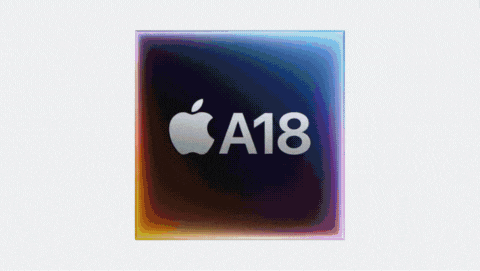
3. Travel content
Travel videos showcase destinations, cultures, and experiences while providing practical information for viewers. The magic of travel content lies in transporting viewers to places they've never been. Effective B-roll should engage all the senses, making viewers feel the sun, smell the street food, and hear the bustling markets.
For travel videos, use B-roll to create immersive experiences that capture the essence of a location.
Types of B-roll to use:
- Aerial drone footage of landscapes and cityscapes
- Time-lapse sequences of busy locations or natural phenomena
- POV footage walking through markets, streets, or attractions
- Close-ups of local food, crafts, and cultural details
- Transportation sequences (trains, boats, planes) to show transitions
- Slow-motion footage of unique activities or memorable moments
Travel channels like Expedia demonstrate this approach excellently. Their city guide videos blend narrator voiceovers with extensive B-roll that showcase everything from iconic landmarks to hidden local gems, creating a comprehensive visual tour that inspires viewers to visit.
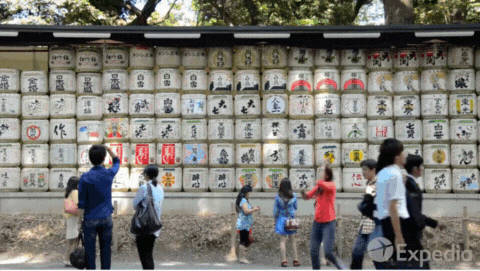
4. News reporting
News segments deliver factual information about current events, often featuring reporter stand-ups and expert interviews. In the news, B-roll is essential evidence. The right B-roll can transform a verbal report into an irrefutable visual document of events.
For news content, use B-roll to provide crucial context and verification of reported facts.
Types of B-roll to use:
- Footage from the scene of events being reported
- Public documents, headlines, or social media posts relevant to the story
- Exterior shots of buildings where events took place
- Archival footage for historical context
- Expert demonstrations or explanations
- Reaction shots from affected community members
60 Minutes demonstrates exceptional B-roll usage in their investigative pieces, where carefully selected footage substantiates claims while maintaining viewer interest throughout longer-form reporting.
5. Product reviews and unboxing
These videos evaluate products by showcasing features, performance, and real-world usage scenarios. The difference between amateur and professional product content is mainly in the B-roll quality. Viewers make purchase decisions based on those close-up product shots far more than on what reviewers actually say.
For product review videos, use B-roll to show rather than tell, providing viewers with visual proof of your claims.
Types of B-roll to use:
- Multiple angles of the product in good lighting
- Close-up shots of important features and details
- Comparison shots with competing products
- "In-the-wild" usage footage showing the product in realistic settings
- Before/after results for products with visible effects
- Durability test footage for relevant products
MKBHD (Marques Brownlee) exemplifies outstanding product B-roll with his tech reviews, which feature cinematic product shots with perfect lighting, smooth camera movements, and high production values that highlight every important aspect of the products.
6. Social media content
Short-form videos designed for quick consumption that need to capture attention immediately and deliver information efficiently. On social platforms, you have three seconds to grab attention before users scroll fast. Well-chosen B-roll can stop the scroll and compel viewers to watch the full video.
For social media videos, use B-roll that creates immediate visual impact and maintains a rapid pace. The optimal approach for most platforms is the "hook and hold" method—start with your most captivating B-roll in the first 3 seconds, then maintain a fast pace.
Types of B-roll to use:
- Fast-paced montages showing multiple aspects of a topic
- Text overlay moments that emphasize key points
- Trending visual styles or transitions appropriate to the platform
- Behind-the-scenes glimpses that feel authentic and personal
- User-generated content or testimonials
- Quick demonstration clips that show rather than tell
Top TikTok creators like Zach King demonstrate the power of B-roll in social formats, using seamless transitions between carefully planned shots to create content that appears magical and compels viewers to watch repeatedly.
7. Music videos
Visual interpretations of music that tell a story create a mood or showcase performers. In music videos, the distinction between A-roll and B-roll often blurs. Performance footage and narrative sequences work together to create a unified visual experience that amplifies the emotional impact of the music.
For music videos, use B-roll to establish visual themes that complement the sonic elements. Unlike other formats, music videos often employ a rhythmic editing approach where B-roll cuts sync with musical beats.
Types of B-roll to use:
- Narrative story elements that build on lyrics
- Abstract visual metaphors that match the emotional tone
- Performance footage from multiple angles and distances
- Reaction shots from audience or band members
- Environmental elements that establish the setting
- Visual effects sequences that enhance the artistic vision
Childish Gambino's "This Is America" demonstrates a masterful integration of performance and conceptual B-roll, with carefully choreographed foreground action contrasted against powerful background elements that add layers of meaning to the music.
8. Real estate videos
Property showcases are designed to highlight features, layout, and the lifestyle a home offers. A real estate B-roll should tell the story of what life would be like in this home. The most effective property videos create emotional connections through aspirational lifestyle footage, not just room tours.
For real estate videos, use B-roll to showcase property features while stimulating emotional responses. The industry's leading producers typically use minimal on-camera presence, with approximately 10% agent introduction and 90% property footage, organized in a logical flow that mirrors how someone would naturally explore the home.
Types of B-roll to use:
- Aerial footage of the property and surrounding neighborhood
- Time-lapse sequences showing different lighting throughout the day
- Seasonal footage for properties with distinctive seasonal features
- Lifestyle vignettes showing how spaces can be used
- Close-ups of premium finishes, fixtures, and materials
- Neighborhood amenities and nearby attractions
High-end real estate platform Sotheby's International Realty exemplifies this approach with property videos that blend cinematic drone footage, elegant interior tracking shots, and subtle lifestyle elements to create immersive property experiences rather than simple visual tours.
Common Pitfalls and Solutions
1. Avoiding overuse
Like any powerful tool, B-roll can be overused. The primary purpose of B-roll is to enhance your story, not overshadow it.
Be selective in your implementation, using B-roll when it truly adds value rather than simply because it is available.
2. Maintaining narrative focus
Illustrative footage makes the visual more appealing but shouldn’t take away from the verbal message. Each attribute of B-roll must have a defined role in your narrative and may focus on setting the scene, illustrating a fact or theme, or offering a powerful emotional appeal.
One question you should ask yourself is whether the B-roll footage enhances your story or whether it is tangential.
3. Final polish and review
The final stage of B-roll implementation involves stepping back and viewing your work with fresh eyes.
Try to watch your edit from a viewer’s perspective. Paying attention to how the B-roll affects the overall flow and impact of your story. Look for opportunities where you can refine transitions with the help of B-roll. You can adjust timing or even remove B-roll that does not serve your narrative goals.
What next?
The steady evolution of video production has established B-roll as an indispensable element in storytelling. The ability of B-roll to solve technical challenges, enhance narrative depth, and create emotional connections makes it a fundamental skill for any content creator. Mastering B-roll techniques helps deliver high-quality, engaging content that resonates with audiences across all platforms. Armed with these strategies and best practices, videographers can confidently craft compelling visual stories that meet today's professional standards.
